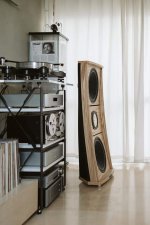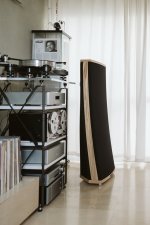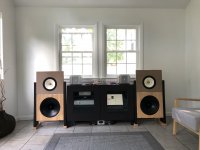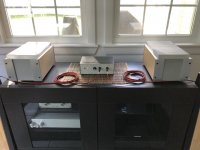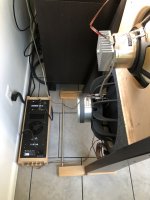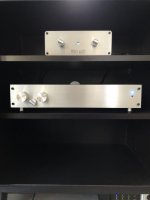Some 18 have very heavy cones, suitable for subwoofer duties only. Faital Pro 18fh500 and 510 have the lightest cone, and perform superb 30-250hzI tried 4 pcs 18 dayton umax without baffle sub, measuredly it is a killer and it plays loud, but it is not the dipole sound I like, not the weightless quick sound
have tried 3-4 solutions with 18 inches, always fall back to 15´ as the best choice for dipole bass
Dayton 655g (fs20hz , eff 88db)
Faital 137g (fs30hz, eff 100db)
That is quite a difference, they ain't gonna sound the same.
Last edited:
Peak acceleration of a woofer might be a possible predictor of low frequency high displacement impact in an OB?
Driver cone wt might only be the start. A compliant suspension, low inductance and strong motor may be other factors.
The FaitalPRO 18FH500 compared to the Dayton looks designed as a woofer rather then a sub, with better QMS, Cms, Le and Bl:
FaitalPRO 18FH500 on OB 80-100Hz a~1,500m/s2

Dayton UM18-22 on OB 80-100Hz a~ 500m/s2

Driver cone wt might only be the start. A compliant suspension, low inductance and strong motor may be other factors.
The FaitalPRO 18FH500 compared to the Dayton looks designed as a woofer rather then a sub, with better QMS, Cms, Le and Bl:
FaitalPRO 18FH500 on OB 80-100Hz a~1,500m/s2
Dayton UM18-22 on OB 80-100Hz a~ 500m/s2
I've seen this layout (two unbaffled woofers facing each other) before but it puzzles me. I'm scratching my head to understand what the benefit is compared to a single woofer. And I can't work out how you'd connect the pair. Because if they move together (both drivers moving towards the listener at the same time), then surely there would be significant cancellation of the "inner" radiation, so that you'd get pretty much the same SPL at the listening position as a single OB woofer would give. But if they are connected so they move in opposition to one another, they will not radiate in a dipole pattern, but in a quadrupole pattern, which is probably not desirable either.I tried 4 pcs 18 dayton umax without baffle sub, measuredly it is a killer and it plays loud, but it is not the dipole sound I like, not the weightless quick sound
have tried 3-4 solutions with 18 inches, always fall back to 15´ as the best choice for dipole bass
Can I ask how yours are (or were) connected, and what your thinking is?
I've seen this layout (two unbaffled woofers facing each other) before but it puzzles me. I'm scratching my head to understand what the benefit is compared to a single woofer. And I can't work out how you'd connect the pair. Because if they move together (both drivers moving towards the listener at the same time), then surely there would be significant cancellation of the "inner" radiation, so that you'd get pretty much the same SPL at the listening position as a single OB woofer would give. But if they are connected so they move in opposition to one another, they will not radiate in a dipole pattern, but in a quadrupole pattern, which is probably not desirable either.
Can I ask how yours are (or were) connected, and what your thinking is?
yes, mine play in the same direction, it gives 6 db more output, but it also requires double power, double amplifiers. I also tried simple elements in a small baffle, but it shakes like hell when you play loud, you connect 2 pieces together and hang them from the magnets there are no vibrations, you can play 120 db 30 hz with that arrangement, pretty sick without baffle, but as I said, this is not the open baffle sound I want, the bass seems slow, probably the amplifiers can not control the heavy-duty elements as they should, I like better 15 inches with efficiency 95-97 db, I have also tested AE and Gpa 18, I still like 15 inches best
Thanks, that's interesting. Do measurements confirm that you really get 6dB extra across the operating range? I've always been concerned that arranging drivers like that would result in substantial cancellation of the 'inner' radiation.yes, mine play in the same direction, it gives 6 db more output, but it also requires double power, double amplifiers. I also tried simple elements in a small baffle, but it shakes like hell when you play loud, you connect 2 pieces together and hang them from the magnets there are no vibrations, you can play 120 db 30 hz with that arrangement, pretty sick without baffle, but as I said, this is not the open baffle sound I want, the bass seems slow, probably the amplifiers can not control the heavy-duty elements as they should, I like better 15 inches with efficiency 95-97 db, I have also tested AE and Gpa 18, I still like 15 inches best
That’s why slob is great. Smaller drivers for low mass, opposed motion for force cancellation, slot loading for cone control and some directional gain, driver arranged for suspension distortion reduction. I used 8x 6.5in woofers is same area as much larger driver but speed of smaller drivers. The slot loading depth provides natural acoustic low pass filter. Article by Nelson Pass (he used 6x 8in woofers):
http://www.enjoythemusic.com/diy/0911/slot_loaded_open_baffle_speaker.htm
The force cancellation is a big deal because even at full volume - full force, the speaker cabinet doesn’t shake. Here’s how I arranged the drivers - magnet facing cone so that motions are in opposite directions relative to driver frame but push-push in slot to squeeze air out by flipped polarity between two drivers. 8 drivers wired 4 parallel / 2 series / 2 parallel for 4ohms nominal. Distortion was -45dB at 50Hz and 90dB. Very clean sounding.

http://www.enjoythemusic.com/diy/0911/slot_loaded_open_baffle_speaker.htm
The force cancellation is a big deal because even at full volume - full force, the speaker cabinet doesn’t shake. Here’s how I arranged the drivers - magnet facing cone so that motions are in opposite directions relative to driver frame but push-push in slot to squeeze air out by flipped polarity between two drivers. 8 drivers wired 4 parallel / 2 series / 2 parallel for 4ohms nominal. Distortion was -45dB at 50Hz and 90dB. Very clean sounding.
Last edited:
Thanks, Fedde!
With wings:

The side wings makes it a U baffle with effective baffle width of about 28in to give good bass extension. The bass goes down to about 37Hz -6dB and 44Hz -3dB no EQ. Sensitivity is about 90.5dB at 2.83v (but 4ohms) and this is with OB losses etc.
Given the massive cone area and low distortion, if this was actively driven with DSP, it would be easy to get more bass extension. Passive crossover is at 470Hz between bass and mid (PRV 5MR450NdY) and 4700Hz between mid and planar (GRS PTT2522-4) tweeters. Here is SLOB bass array raw response - note that I was able to tame some of the HD peaks near 200Hz to 400Hz with butyl rubber applied to the basket.

Overall response with 3 way passive crossover:

crossover response:

More info here.
With wings:
The side wings makes it a U baffle with effective baffle width of about 28in to give good bass extension. The bass goes down to about 37Hz -6dB and 44Hz -3dB no EQ. Sensitivity is about 90.5dB at 2.83v (but 4ohms) and this is with OB losses etc.
Given the massive cone area and low distortion, if this was actively driven with DSP, it would be easy to get more bass extension. Passive crossover is at 470Hz between bass and mid (PRV 5MR450NdY) and 4700Hz between mid and planar (GRS PTT2522-4) tweeters. Here is SLOB bass array raw response - note that I was able to tame some of the HD peaks near 200Hz to 400Hz with butyl rubber applied to the basket.
Overall response with 3 way passive crossover:
crossover response:
More info here.
Last edited:
That’s why slob is great. Smaller drivers for low mass, opposed motion for force cancellation, slot loading for cone control and some directional gain, driver arranged for suspension distortion reduction. I used 8x 6.5in woofers is same area as much larger driver but speed of smaller drivers. The slot loading depth provides natural acoustic low pass filter. Article by Nelson Pass (he used 6x 8in woofers):
http://www.enjoythemusic.com/diy/0911/slot_loaded_open_baffle_speaker.htm
The force cancellation is a big deal because even at full volume - full force, the speaker cabinet doesn’t shake. Here’s how I arranged the drivers - magnet facing cone so that motions are in opposite directions relative to driver frame but push-push in slot to squeeze air out by flipped polarity between two drivers. 8 drivers wired 4 parallel / 2 series / 2 parallel for 4ohms nominal. Distortion was -45dB at 50Hz and 90dB. Very clean sounding.
View attachment 1063196
hi, very exciting the slob solution, I can ask, what is the max spl on this bass arrangement, and shakes the construction if one plays loud?
I was listening at 98dB at about 2.5m away and the sound was still clear and head room was still there. The woofers can take about 500w because there are 8 of them. The mid range is a PA driver rated for 225W and 95dB sensitivity.

2.83v at 4ohms is 2W. If we assume max power is about 500W, that is about 24dB on top of 91dB so 115dB max SPL.
At 98dB at 2.5m there was no cabinet vibration from driver motion. Only the air pressure pushing on the wings but that was minimal.
2.83v at 4ohms is 2W. If we assume max power is about 500W, that is about 24dB on top of 91dB so 115dB max SPL.
At 98dB at 2.5m there was no cabinet vibration from driver motion. Only the air pressure pushing on the wings but that was minimal.
Hi,
my last test open baffle:


2 x Kenford HW1206 bass,
Sica without the whizzercone,
cheap 49cent noname-chassis mounted at Horn from an old BELL-PA,
Dayton mini-8 AMT
passiv and aktiv by miniDSP 2x4HD
This one works really great, but show must go on...
my current openbaffle, shown on the german "Frickelfest Essential 2021"

2x12" Kenford HW1206Bass in folded Dipol like the "Eternal Arts" Dipol,
Top Design is a mix on the basis from Alexander Heissmann Acoustic and the sidewing-theorie (2"and15") by GR-Research
Speakers are Blaupunkt Suprakustik and seas DXT
xover and filtered by miniDSP 4x10HD and powered by 2x24Volt Akku-powered TDA7294 class AB-Amplifiers
my corrent projekt:
openbaffle-passivmembran

The Idea is based on the AlphaPat20.
my version is a little bit smaller, only 15" passiv membrane (from an old broken JBL-Chassis, driven by a Visaton W130S. for mid andhHigh I use Visaton FRS7A behind a self designed and 3D-printing waveguide.
xover and filtered by minidsp 4x10HD,
powered by TDA 7294 ampfifiers, modified with meanwell switching power supply.
I´m looking for an used miniDSP nanoDIGi 2x8 for further experiments.
nice greatings and best wishing from germany/Hamburg, Hartmut
my last test open baffle:
2 x Kenford HW1206 bass,
Sica without the whizzercone,
cheap 49cent noname-chassis mounted at Horn from an old BELL-PA,
Dayton mini-8 AMT
passiv and aktiv by miniDSP 2x4HD
This one works really great, but show must go on...
my current openbaffle, shown on the german "Frickelfest Essential 2021"
2x12" Kenford HW1206Bass in folded Dipol like the "Eternal Arts" Dipol,
Top Design is a mix on the basis from Alexander Heissmann Acoustic and the sidewing-theorie (2"and15") by GR-Research
Speakers are Blaupunkt Suprakustik and seas DXT
xover and filtered by miniDSP 4x10HD and powered by 2x24Volt Akku-powered TDA7294 class AB-Amplifiers
my corrent projekt:
openbaffle-passivmembran
The Idea is based on the AlphaPat20.
my version is a little bit smaller, only 15" passiv membrane (from an old broken JBL-Chassis, driven by a Visaton W130S. for mid andhHigh I use Visaton FRS7A behind a self designed and 3D-printing waveguide.
xover and filtered by minidsp 4x10HD,
powered by TDA 7294 ampfifiers, modified with meanwell switching power supply.
I´m looking for an used miniDSP nanoDIGi 2x8 for further experiments.
nice greatings and best wishing from germany/Hamburg, Hartmut
I have copied PAP original design previously, they have made several designs which are not so different, but the latest one Trio Classic is looking very good especially the wood tone & black cloth
https://www.pureaudioproject.com/classic15-open-baffle-speakers-by-pureaudioproject/
https://www.pureaudioproject.com/classic15-open-baffle-speakers-by-pureaudioproject/
Attachments
So I don’t believe I’ve ever posted in this “Ultimate” open baffle thread…however, I’ve been playing with open baffle experiments for a while.
My current iteration has me feeling warm and fuzzy all over, so I thought I’d share.
This is my Sunroom “experimental” system.
I was a bit anxious to hear my new drivers that I rebuilt the top end of the panels for…so I skipped paint.
System description:
I use a Macbook Pro as a source here…until I build a second analog front end 😁
The Mac plays into my DCB1 which has been modified with Jensen JT-123-FLPCH at the output for about 6dB of gain.
The DCB1 feeds the signal to a First Watt B5. Most filtering done here.
From there the signal is sent to a pair Hypex FA 502 which are set with only a high pass to protect the woofers from signals bellow about 30Hz.
The Hypex amps drive a pair of Acoustic Elegance Dipole 15-16 with voice coils wired in parallel for an 8 Ohm load.
The high frequencies are sent to my F2J monoblock clones which are currently driving my newest addition which is a pair of Sonido SWR250 field coil drivers.
The original panels weren’t too far off in dimensions from Leon Huijgen’s “Leonidas” design. I came across his article and had previously searched out a pair of used Lii Audio Crystal 10 drivers to try in my panels to good effect.
Here I tried to mimic (not the first) the design closer by adding a modular upper panel (a la PAP) and maintaining the small gap he prescribed in his original design between panels.
Dimensions are almost identical. Only difference I maintained was leaving a gap at the bottom of the bass panel as I wanted the option of adding a second pair of slot loaded woofers (like Papa Pass’s 2nd gen SLOB) for use with a variety of other high frequency solutions that will have an even higher sensitivity than the current set up.
Is this the “Ultimate”…probably not. However, its ability to produce absolute foot tapping joy is undeniable.
My current iteration has me feeling warm and fuzzy all over, so I thought I’d share.
This is my Sunroom “experimental” system.
I was a bit anxious to hear my new drivers that I rebuilt the top end of the panels for…so I skipped paint.
System description:
I use a Macbook Pro as a source here…until I build a second analog front end 😁
The Mac plays into my DCB1 which has been modified with Jensen JT-123-FLPCH at the output for about 6dB of gain.
The DCB1 feeds the signal to a First Watt B5. Most filtering done here.
From there the signal is sent to a pair Hypex FA 502 which are set with only a high pass to protect the woofers from signals bellow about 30Hz.
The Hypex amps drive a pair of Acoustic Elegance Dipole 15-16 with voice coils wired in parallel for an 8 Ohm load.
The high frequencies are sent to my F2J monoblock clones which are currently driving my newest addition which is a pair of Sonido SWR250 field coil drivers.
The original panels weren’t too far off in dimensions from Leon Huijgen’s “Leonidas” design. I came across his article and had previously searched out a pair of used Lii Audio Crystal 10 drivers to try in my panels to good effect.
Here I tried to mimic (not the first) the design closer by adding a modular upper panel (a la PAP) and maintaining the small gap he prescribed in his original design between panels.
Dimensions are almost identical. Only difference I maintained was leaving a gap at the bottom of the bass panel as I wanted the option of adding a second pair of slot loaded woofers (like Papa Pass’s 2nd gen SLOB) for use with a variety of other high frequency solutions that will have an even higher sensitivity than the current set up.
Is this the “Ultimate”…probably not. However, its ability to produce absolute foot tapping joy is undeniable.
Attachments
Your system looks good. The baffles seem close to the front wall. Is it intentional/does it sound better that way?The original panels weren’t too far off in dimensions from Leon Huijgen’s “Leonidas” design. I came across his article and had previously searched out a pair of used Lii Audio Crystal 10 drivers to try in my panels to good effect.
Here I tried to mimic (not the first) the design closer by adding a modular upper panel (a la PAP) and maintaining the small gap he prescribed in his original design between panels.
Can I ask you a link to Leon's article you mentioned? I have wondered about the gap between panels.
“The baffles seem close to the front wall. Is it intentional/does it sound better that way?”
What I have noticed in this room is that by having the baffles aligned with the front of the equipment cabinet the sound quality is improved overall. I suppose it acts as an extension of the baffles.
The room is a bit strange in dimensions in that it is only about 12 feet wide and 15 feet long , but has a 10 foot high ceiling for the central area that slopes off towards the ends of the room to about 7 feet at the far walls.
I’ve read a lot about prescribed placement with open baffles. Let’s face it…you have to work with what you have, and this is what’s realistic in this room.
I would say there is a little more than 2 feet between the wall and the back the baffles.
Originally the entire back of the baffles were covered with a heavy felt to help damp any direct reflections off the rear wall. Not sure how much it really worked. I haven’t tried anything with the new upper panels yet.
This is a very lively sounding room. It mimics the spaciousness of concert hall recordings well at times. Not by plan.
Leonidas article:
http://www.modelpromo.nl/audio-dandy/reviews/The Liiondias Open Baffle Speaker/The Liionidas Open Baffle speaker.pdf
What I have noticed in this room is that by having the baffles aligned with the front of the equipment cabinet the sound quality is improved overall. I suppose it acts as an extension of the baffles.
The room is a bit strange in dimensions in that it is only about 12 feet wide and 15 feet long , but has a 10 foot high ceiling for the central area that slopes off towards the ends of the room to about 7 feet at the far walls.
I’ve read a lot about prescribed placement with open baffles. Let’s face it…you have to work with what you have, and this is what’s realistic in this room.
I would say there is a little more than 2 feet between the wall and the back the baffles.
Originally the entire back of the baffles were covered with a heavy felt to help damp any direct reflections off the rear wall. Not sure how much it really worked. I haven’t tried anything with the new upper panels yet.
This is a very lively sounding room. It mimics the spaciousness of concert hall recordings well at times. Not by plan.
Leonidas article:
http://www.modelpromo.nl/audio-dandy/reviews/The Liiondias Open Baffle Speaker/The Liionidas Open Baffle speaker.pdf
Why not let the F15 take it all the way to the top? Just curious...
Got the idea from the Decware forum and youtube where owners of the F-15 are pairing it with the Fast 8 wired in parallel with no crossover. Not something I thought would work but you live and learn.
Thank you!“The baffles seem close to the front wall. Is it intentional/does it sound better that way?”
What I have noticed in this room is that by having the baffles aligned with the front of the equipment cabinet the sound quality is improved overall. I suppose it acts as an extension of the baffles.
The room is a bit strange in dimensions in that it is only about 12 feet wide and 15 feet long , but has a 10 foot high ceiling for the central area that slopes off towards the ends of the room to about 7 feet at the far walls.
I’ve read a lot about prescribed placement with open baffles. Let’s face it…you have to work with what you have, and this is what’s realistic in this room.
I would say there is a little more than 2 feet between the wall and the back the baffles.
Originally the entire back of the baffles were covered with a heavy felt to help damp any direct reflections off the rear wall. Not sure how much it really worked. I haven’t tried anything with the new upper panels yet.
This is a very lively sounding room. It mimics the spaciousness of concert hall recordings well at times. Not by plan.
Leonidas article:
http://www.modelpromo.nl/audio-dandy/reviews/The Liiondias Open Baffle Speaker/The Liionidas Open Baffle speaker.pdf
The biggest difference seems your wings to be significantly shallower than Leonidas' at 30cm. How low do your speakers go, or maybe you have subs, or type of music?
I was looking into trying something similar with an 18" so your post was timely!
- Home
- Loudspeakers
- Multi-Way
- Ultimate Open Baffle Gallery
